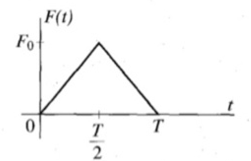Question
1. Solve problem by means of the method based on the discrete-time transition matrix. 2. Solve problem for the triangular pulse shown in Fig 4.32
1. Solve problem by means of the method based on the discrete-time transition matrix.
2. Solve problem for the triangular pulse shown in Fig 4.32 with T = 0.1 s. Caution: Do not confuse the pule duration T with the sampling period T.
3. Solve problem by means of the convolution sum. Plot the response using the sampling period T = 0.003 s and the number sampling times n = 200.
Derive the response of a viscously damped single-degree-of-freedom system to the force F(t) = F 0 e -?t ?(t) by means of the convolution integral. Plot the response for the system parameters m = 12 kg, c = 24 N ? s/m, k = 4,800 N/m and the force parameter F 0 = 200 N, ? = 1.
Figure 4.32

These problem from Leonard Meirovitch book for fundamental of mechanical vibration.
Fo F(t) T 2 T
Step by Step Solution
3.48 Rating (151 Votes )
There are 3 Steps involved in it
Step: 1
The solution for this problem can be obtained as followings Analysis From the conv...
Get Instant Access to Expert-Tailored Solutions
See step-by-step solutions with expert insights and AI powered tools for academic success
Step: 2

Step: 3

Ace Your Homework with AI
Get the answers you need in no time with our AI-driven, step-by-step assistance
Get Started


